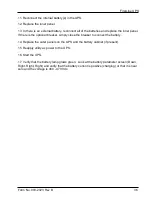
FirstLine UPS
Form No. 003-2323 Rev B
32
Special Considerations for Connection Batteries to the FirstLine UPS, including
Extended Run Time Battery Cabinets
It is never safe to work within either the UPS or the extended battery cabinet while the UPS
is powered. The battery produces a lethal voltage whether or not the UPS is powered or
running. Always work with extreme caution. No service work should be performed unless
the personnel are properly trained and appropriate tools and equipment are available.
All batteries must be connected to the UPS prior to starting the rectifier. The rectifier runs
whenever the UPS is on. If a battery is disconnected while the rectifier is running (for
example, if the optional breaker on an extended battery cabinet is opened while the UPS is
running), it must not be closed without first stopping the rectifier. This same precaution
applies to opening the external user supplied battery disconnect device. If one is present.
Connecting a battery while the rectifier is running will cause equipment damage that is not
covered by the equipment warranty. See the procedure, below, for stopping the rectifier.
It is essential that the Extended Battery Cabinet be connected with the proper polarity.
Reverse polarity will cause equipment damage that is not covered by the equipment
warranty. There is a polarity verification procedure, below, that will help to prevent mishaps.
Wires should be marked using colored tape to avoid confusion. Note that the terminal block
in the UPS and the terminal blocks in the Extended Battery Cabinet all use the left-hand
terminal for the positive connection and the right-hand terminal for the negative connection.
Before connecting the wires between the UPS and the Extended Battery Cabinet, the UPS
must be powered down, the front outer panel must be removed, the front inner safety panel
must be removed, and all internal batteries must be disconnected by unplugging the red
and black battery plug from the DC input plug for each battery string. Most units have one
battery string, but a second string is an option in the tall cabinet version. On the Extended
Battery Cabinet, the front outer panel must be removed, the front inner safety panel must
be removed, and all internal batteries must be disconnected by unplugging the red and
black battery plugs between each battery string and the plug pair between the lowest
battery string and the input/output panel. Connect the three wires (positive, negative, and
ground) to the external battery terminal block and the grounding stud at the UPS end.
Connect the Extended Battery Cabinet end of the three wires to the terminal block on the
left and to the ground stud. The positive wire goes to the left-hand terminal and the
negative wire goes to the right-hand terminal. If additional cabinets are to be added, run the
three wires from the first cabinet to the second using the right-hand terminal block in the
first cabinet and the left-hand terminal block in the second cabinet. If a third cabinet is
present, run the three wires from the second cabinet to the third using the right-hand
terminal block in the second cabinet and the left-hand terminal block in the third cabinet.
Polarity Verification Procedure
Check to make sure that all wiring is proper and secure and that all personnel are clear of
hazardous circuits.
For this procedure, the UPS should be off with no power applied.
Summary of Contents for FirstLine
Page 43: ......








































